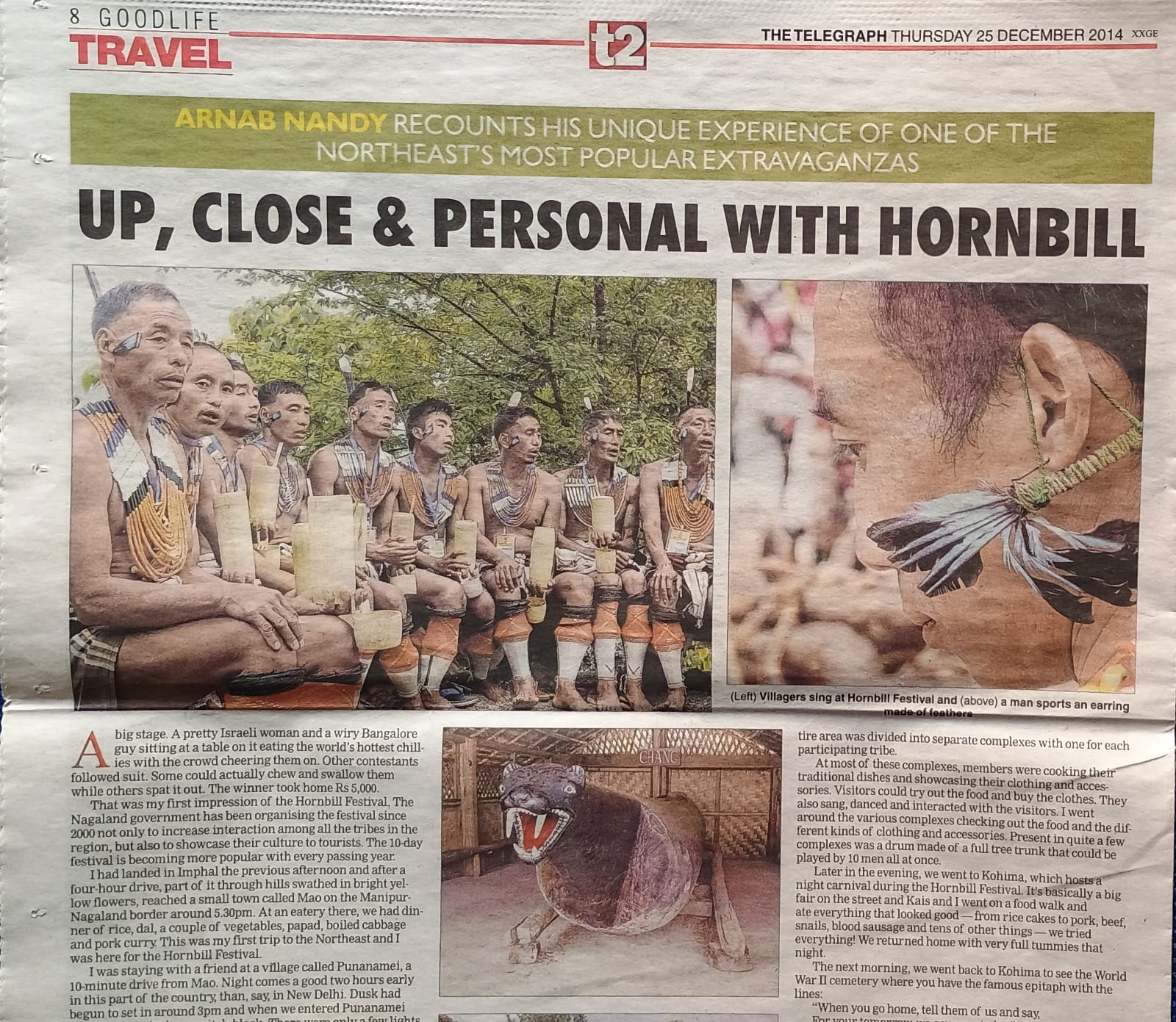A big stage. A pretty Israeli woman and a wiry Bangalore guy sitting at a table on it eating the world’s hottest chillies with the crowd cheering them on. Other contestants followed suit. Some could actually chew and swallow them while others spat it out. The winner took home Rs 5,000.
That was my first impression of the Hornbill Festival. The Nagaland government has been organising the festival since 2000 not only to increase interaction among all the tribes in the region, but also to showcase their culture to tourists. The 10-day festival is becoming more popular with every passing year.
I had landed in Imphal the previous afternoon and after a four-hour drive, part of it through hills swathed in bright yellow flowers, reached a small town called Mao on the Manipur- Nagaland border around 5.30pm. At an eatery there, we had dinner of rice, dal, a couple of vegetables, papad, boiled cabbage and pork curry. This was my first trip to the Northeast and I was here for the Hornbill Festival.
I was staying with a friend at a village called Punanamei, a 10-minute drive from Mao. Night comes a good two hours early in this part of the country, than, say, in New Delhi. Dusk had begun to set in around 3pm and when we entered Punanamei shortly after six, it was pitch-black. There were only a few lights and I found my friend, Kais’ home running on solar power.
When you’re in a village without electricity after dark, there isn’t much to do. What I figured out on my first night there was that people finished their dinner around six and got into bed around eight. They, of course, rose with the sun at five the next morning.
Kais offered me coffee and we sat in her kitchen, which I decided was my favourite room in the house. They had a gas oven, but they did most of the cooking on firewood.
I had never been to a house with a hearth before and found it fascinating. A big kettle full of water was constantly on the boil. The water was used for everything from making tea to taking a bath. Above the fire hung chunks of beef and pork left to smoke.
We retired to our rooms shortly after eight and I fell asleep around nine.
On our way to the Hornbill Festival venue the next day, which was the inaugural day of the festival, we encountered hundreds of people attired in colourful traditional garb, pulling a huge block of stone.
Kais explained stone-pulling was a ritual they performed on important occasions. And that day, they were carrying out a dress rehearsal of the actual event, which was to take place the following day. It was very interesting and no one seemed to mind though the ritual blocked a part of the arterial road.
The chilli-eating contest was on when we reached the Naga Heritage Village, the venue of the festival.
After it was over, we explored the rest of the place. The entire area was divided into separate complexes with one for each participating tribe.
At most of these complexes, members were cooking their traditional dishes and showcasing their clothing and accessories. Visitors could try out the food and buy the clothes. They also sang, danced and interacted with the visitors. I went around the various complexes checking out the food and the different kinds of clothing and accessories. Present in quite a few complexes was a drum made of a full tree trunk that could be played by 10 men all at once.
Later in the evening, we went to Kohima, which hosts a night carnival during the Hornbill Festival. It’s basically a big fair on the street and Kais and I went on a food walk and ate everything that looked good-from rice cakes to pork, beef, snails, blood sausage and tens of other things- we tried everything! We returned home with very full tummies that night.
The next morning, we went back to Kohima to see the World War II cemetery where you have the famous epitaph with the lines:
“When you go home, tell them of us and say,
For your tomorrow, we gave our today.”
The information boards there talked about a British army defeating the Japanese.
There were also graves and plaques marking those Indian soldiers who were cremated. From the history I was taught at school, I remembered Netaji Subhas Chandra Bose had supported the Japanese and intended to ultimately overthrow the British imperialists. But at the cemetery, I found no mention of Bose. It was only at the World War II Museum at the Naga Heritage Village, where we went from Kohima, that they mentioned Bose’s support to the Japanese while describing the Battle of Kohima.
Because of the objective way in which all the information was provided, I asked Kais who the local people supported. She said the British army because first, a number of local people were fighting for them and more importantly, when the Japanese came, they plundered the villages and took away their domestic birds and animals. Naturally, they did not get any sympathy.
Later, we had some delicious pork with fermented beans, snails, which I found very complicated to eat because the shells were still there, and washed it down with rice beer, which tasted quite like lassi but gave you a nice kick.
Hornbill Festival had a lot more to offer over the next eight days and I was especially sad to miss the rock band competition that attracts great bands from across the country. I left for home the following day promising myself to come back.
